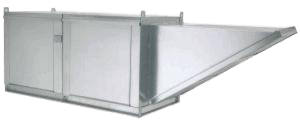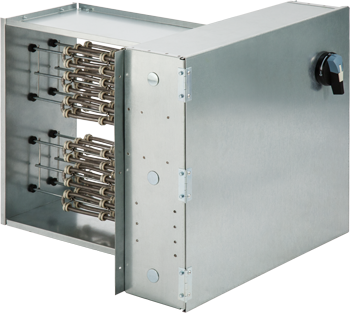DRAWINGS
OPERATION & INSTALLATION MANUALS
- Blower Reorientation »
- Operation and Installation Manual (PDF) »
- Operation and Installation Manual - MUA Controls (PDF) »
ADDITIONAL INFORMATION
- Accessories »
- Direct Drive Option »
- Center of Mass Calculator »
- Modular Packaged Unit Information »
- DX Coil Specifications »
- Electric Insert Specifications »
- Formulas »
- Frequently Asked Heater Questions »
- Heater Video »
- Motor Information »
- Performance Data »
- Product Information »
- Written Specification »
- DDC Points Manual »
VE
MODULATING ELECTRIC HEATER

|
The Modulating Electric Heater is used for tempering make-up air for installation requiring frequent air changes. These modular units are rated up to 257KW with voltages and phases to meet all electrical requirements. Air volume range is 800 - 22,000 CFM and up to 3" wg @ standard air density, depending on the heating requirements. These heaters are intended for indoor and outdoor installations in commercial kitchens, factories, foundries and similar commercial and industrial occupancies. Combination packages that include both the exhaust and the supply fans mounted on a single roof curb are also available. Contact your local sales representative for more information. These electric heaters use SCR technology "Silicon Controlled Rectifier;" technology is also called current value because of its ability to modulate the current supplied to, and consequently, the capacity of the heater. The net heat output is the product of the KW capacity of the heater multiplied by the ratio of the "ON" to "ON+OFF" or "period" time. This ratio is determined by an electronic logic in the SCR according to a signal from a proportioning thermostat. Enough heat is stored in the electric elements so that there is an almost constant operating temperature corresponding to the demand. This method, Modulating Control Mode, is also referred to as "proportional." The heater is electronically controlled to deliver anywhere from zero to 100% of its capacity, precisely and smoothly, matching the heat demand of the system. This is achieved by an SCR controller connected to a proportioning thermostat, which may be either a duct type for Fresh Air make-up or a room type for zone heating. Proportional refers to the portion of a time period in which the heating element is turned ON and OFF (e.g. 10% ON and 90% OFF meaning 10% of the heating capacity). According to the thermostat demand, the heater is pulsed in different proportion of ON time and OFF time to match the heating demand. A proportional control can thus maintain an accurate room or discharge temperature without the typical variations of the ON/OFF method. This represents an energy savings of approximately 15% due to the high differential of ON/OFF controls. |
FEATURES & BENEFITS
|
OPTIONS
|
ADDITIONAL IMAGES
